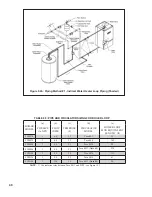
1) Line Voltage (120 VAC) Connections (Figure 10.1) – The line voltage connections are located in the junction box on the
right side of the vestibule:
• Black – Line voltage “hot”
• White – “Neutral” for boiler and circulators
• Red – “Heating” circulator “hot”
• Blue – “Indirect Water Heater “ circulator “hot”
• Green – Ground connection
2) Maximum circulator continuous current draw is 2A. When Piping Method #1 is used, it may be desirable to use the
boiler to directly control the primary circulator in addition to the secondary circulator. If this is done, control both
heating circulators using a relay with a 120VAC coil, such as a Honeywell R4222, as shown in Figure 10.3. Select a
relay with a contact rating in excess of the combined draw of the two circulators.
3) Low Voltage Connections (Figure 10.1) – These connections are screw terminals located on the terminal strip next to
the junction box on the left:
• Terminals 1 and 2 – “Heating” thermostat connections
• Terminals 3 and 4 – “External Limit Control” connections
• Terminals 5 and 6 – “Outdoor Reset Sensor” connections
• Terminals 7 and 8 – “Domestic Indirect Water Heater” thermostat connections
• Terminal 9 – “Flame Signal Reading”
• Heat anticipator setting for the thermostat connection is 0.1 A when thermostat is connected directly to terminals 1
and 2.
Warning
All wiring and grounding must be done in accordance with the authority having
jurisdiction or, in the absence of such requirements, with the National Electrical
Code (ansi/nFPa 70).
X Wiring
CauTiOn
WHEn MaKing lOW VOlTagE COnnECTiOns, MaKE surE THaT nO
EXTErnal POWEr sOurCE is PrEsEnT in THE THErMOsTaT Or
liMiT CirCuiTs. iF suCH a POWEr sOurCE is PrEsEnT, iT COulD
DEsTrOY THE bOilEr’s MiCrOPrOCEssOr COnTrOl (MCba).
OnE EXaMPlE OF an EXTErnal POWEr sOurCE THaT COulD bE
inaDVErTEnTlY COnnECTED TO THE lOW VOlTagE COnnECTiOns
is a TransFOrMEr in OlD THErMOsTaT Wiring.
4) If the outdoor sensor is connected to terminals 5 and 6, the boiler will adjust the target space heating set point supply water
temperature downwards as the outdoor air temperature increases. If used, this sensor should be located on the outside of the
structure in an area where it will sense the average air temperature around the house. Avoid placing this sensor in areas where
it may be covered with ice or snow. In general, locations where the sensor will pick up direct radiation from the sun should
also be avoided. Avoid placing the sensor near potential sources of electrical noise such as transformers, power lines, and
fluorescent lighting. Wire the sensor to the boiler using 22 gauge or larger wire. As with the sensor, the sensor wiring should
be routed away from sources of electrical noise. Where it is impossible to avoid such noise sources, wire the sensor using a
2 conductor, UL Type CM, AWM Style 2092, 300Volt 60°C shielded cable. Connect one end of the shielding on this cable to
ground.
Summary of Contents for FREEDOM
Page 8: ...8 Figure 1 Wall Mounting Hole locations ...
Page 9: ...9 Figure 5 2 Boiler Mounting Hardware ...
Page 11: ...11 Figure 6 1 Boiler Installed In A Confined Space Ventilation Air From Inside ...
Page 42: ...42 FIGURE 7 51 CONDENSATE PIPING ARRANGEMENT ...
Page 55: ...55 Figure 10 1 Wiring Connections Diagram ...
Page 56: ...56 Figure 10 2 Ladder Diagram ...
Page 57: ...57 Figure 10 3 Wiring of Isolation Relay for Control of Two Heating Circulators ...
Page 60: ...60 FCM Series Lighting and Operating Instructions ...
Page 66: ...66 FIGURE 12 2 BASIC MENU TREE ...
Page 75: ...75 ...
Page 77: ...77 ...
Page 79: ...79 ...
Page 80: ...80 ...
Page 81: ...81 ...
Page 83: ...83 150 151 152 153 154 155 ...
Page 84: ...84 156 157 158 159 160 161 ...
Page 85: ...85 162 ...
















































